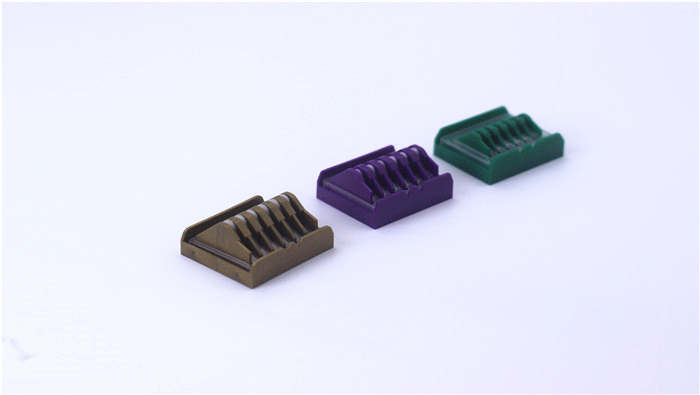
Disposable tissue closure clips (based on paraformaldehyde POM material) have become an indispensable key instrument in minimally invasive surgery due to their biocompatibility, image compatibility and ease of operation. The following is a detailed analysis of the advantages and applicable fields of POM material, taking into account the clinical application scenarios and the characteristics of POM material.

I. General Surgery
1. Cholecystectomy and gastrointestinal surgery
Scenario: In laparoscopic cholecystectomy, gastrectomy, colorectal resection, it is necessary to clip the blood vessels or tissue bundles to control bleeding or close the stump.
Advantage:
Rapid hemostasis: POM material clamp body closes blood vessels by physical pressure, stable clamping force (can withstand 50kPa water pressure for 72 hours without leakage), significantly reducing the risk of intraoperative bleeding.
Anti-slip design: Transverse and longitudinal anti-slip patterns on the inner side of the clamping arm (e.g. Dematic Medical products) increase friction and prevent slipping on smooth tissue surfaces, especially for ligation of gastrointestinal mesenteric vessels.
Multiple sizes: Large (L), Medium (M), Small (S) models are available to match different vessel diameters (e.g., gallbladder artery is usually ligated with medium-sized clips).

2. Hepatosplenectomy
Scenario: Liver lobectomy or splenectomy requires closure of the hilar vessels or splenic pedicle.
Advantage:
High ligature strength: the creep resistance and rigidity of the POM material ensures that there is no risk of disintegration after clamp closure, especially in portal branches with high blood flow
Imaging compatibility: non-magnetic and radiopaque, no artifacts on postoperative CT/MRI, facilitating assessment of the surgical outcom.
II. Urologic and gynecologic surgery
1. Radical prostatectomy with renal surgery
Scenario: Clamping of periprostatic vessels or renal hilar vessels to reduce intraoperative bleeding.
Advantage:
Precise operation: Loose-leaf + bowed nail leg design (e.g., Chongqing Dechuan Medical products) extends the ligation range and adapts to complex anatomical structures.
Tissue protection: the design of groove and rubber pad inside the clamping arm reduces the mechanical damage to the ureter or nerve bundle and reduces postoperative complications.
2. Gynecologic tumor removal and uterine surgery
Scenario: Ovariectomy or hysterectomy with ligamentous vascular closure.
Advantage:
Biocompatibility: POM material does not trigger rejection reactions, long-term retention in the body without the risk of decomposition, suitable for scenarios requiring postoperative removal.
Rapid removal: disassembly mechanism (e.g., disassembly post) simplifies the postoperative removal process and reduces the time for secondary surgery.
III. Thoracic surgery and vascular intervention
1. Cardiovascular bypass and aneurysm resection
Scenario: Clamping of coronary artery branches or peri-aortic aneurysm vessels.
Advantage:
Fatigue resistance: POM material maintains structural stability under repeated blood flow impacts, avoiding the risk of postoperative revascularization.
Miniaturized design: Miniature closure clips (e.g., Dematic Medical's Micro model) are suitable for small coronary artery branches (<2 mm in diameter).
2. Vascular interventions
Scenario: Embolization of an abnormal vessel or temporary blockage of blood flow.
Advantage:
Rapid response: The three-way valve structure supports rapid intraoperative switching between clamping and releasing modes, which is suitable for dynamic surgical requirements.
No magnetic interference: titanium or POM material does not affect intraoperative image navigation, especially suitable for interventional procedures requiring real-time imaging.

IV.Pediatrics and Special Surgery
1. Pediatric surgery and neurosurgery
Scenario: Closure of small blood vessels in children or neurosurgery microvascular hemostasis.
Advantage:
Low invasiveness: POM clip body lightweight design (weight <0.5g), reducing compression damage to fragile tissues.
Tactile sensing: Tactile sensing closure method (e.g. Chongqing Dechuan Medical products), doctors can sense the clamping force to avoid over-pressurization.
2. Endoscopic and robotic surgery
Scenario: adapted to da Vinci surgical robot or single-port laparoscopic instruments.
Advantage:
Compatibility: Standardized interface design is compatible with a variety of clamping forceps, reducing hospital equipment procurement costs.
Precise control: Magnetic anchoring system supports remote operation of the robot, enhancing the precision of complex surgeries.
V. Summary of Core Advantages
Advantages of material properties:
Biocompatibility: POM and titanium materials are non-cytotoxic, safe and reliable for long-term retention in the body.
Sterilization tolerance: ≤10μg/g residue after ethylene oxide sterilization, in line with international safety standards.
Functional design advantages:
Anti-slip and locking safety: 360° locking design (e.g., Segessex products) ensures stable clamping, intraoperative dislodgement rate <0.1%.
Multi-scenario adaptation: 16 sizes covering microvessels to large groups.
Economic Benefit Advantage:
Controllable cost: domestic POM material replaces imported titanium clips with 30%-50% lower price and equivalent performance.
Shorten the operation time: replace the traditional silk ligation, save 10-15 minutes in a single operation.
Conclusion
The single-use POM tissue closure clips, with their material properties and innovative design, show significant advantages in general surgery, urology, cardiovascular surgery and other fields. Its core value lies in enhancing surgical safety, optimizing operational efficiency and reducing comprehensive medical costs. In the future, with the development of degradable POM composite materials (such as polylactic acid modification), this device is expected to be further expanded to clinical scenarios requiring temporary closure, and promote the continuous innovation of minimally invasive surgical technology.
+86 18361958211
marketing@cndonho.com
+86 18361958211
No.2 Zhiwei Road, Qiandeng Town, Kunshan City, Jiangsu Province, China




